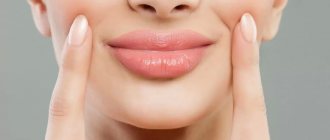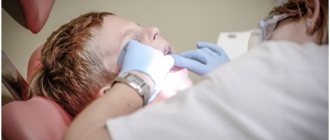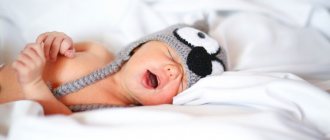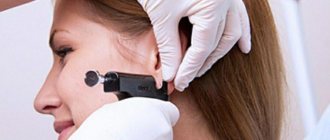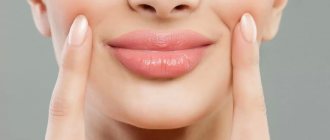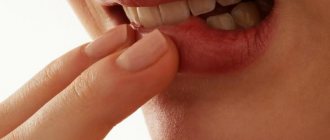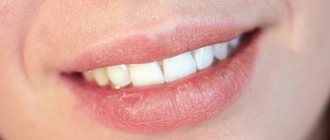Last update: 03/03/2021
Dry lips in a child can turn from a small nuisance into a big problem if care is not taken in time. But it is very easy to ignore this problem - young children may remain silent and not complain, fearing the terrible treatment with pills and injections.
In fact, there are a dozen causes of dry skin. The most common ones seem very simple, but still constantly provoke peeling and cracking of the lips.
How to deal with dry lips in a child?
To care for a child’s lips, only special cosmetics based on natural ingredients, without chemical dyes and fragrances, are suitable. In winter, before going outside, be sure to treat your baby’s lips with a rich hygienic lipstick, which will nourish and protect from the cold, while also lasting long enough.
An alternative to lipstick can be regular baby cream. If you are very dry, you can apply it in a thick layer at night. You can also lubricate your lips with olive or sea buckthorn oil - it leaves a nourishing and protective film on the lips, even if you lick it off.
Balm "La Cree" combines the best of active natural ingredients that soften and heal the skin. This hypoallergenic product can be used for very young children. Active ingredients include: shea butter, almond and castor oils, avocado extract, beeswax, vitamins A and E. This set provides comprehensive care at any time of the year.
What should beautiful and healthy lips look like?
Beautiful and healthy lips are characterized by the following signs:
- evenness and smoothness of the skin;
- symmetry of the corners of the mouth;
- the presence of a pink or red tint to the lips;
- absence of peeling, cracks and purse-string wrinkles;
- convex volume of the labial border;
- absence of jams, pigmentation and pathological manifestations.
It is also important to pay attention to the presence of a hollow above the upper lip and a cupid's arch, which should be clearly defined.
Experts' opinion
According to the results of clinical studies, which involved 50 children aged 0 to 5 years, the products were proven to be highly effective, safe and tolerable for daily skin care of children with mild to moderate forms of atopic dermatitis and during remission, accompanied by a decrease in the quality of life of patients . As a result of therapy, including the use of lip balm, a decrease in the activity of the inflammatory process, a decrease in dryness, itching and flaking was noted.
La Cree Lip Balm has been confirmed to:
- relieves discomfort and dry skin
- restores dry and chapped lips
- moisturizes and protects the delicate skin of the lips from cold and wind
The lack of vitamins can be replenished with the help of children's multivitamin complexes (they differ from adults in composition and dosage), lubricate the lips with vitamins from capsules and, of course, eat more foods rich in vitamins.
To humidify indoor air, you can use special humidifiers or simply place containers of water next to the radiators.
In the first days
During the first time after birth, a light gray or creamy coating - remnants of smegma, the original lubricant. If there is not a lot of plaque, it will gradually be absorbed into the skin. However, if the plaque is abundant, it is recommended to remove it, since after a day or two the fats it contains oxidize, causing the proliferation of microorganisms and, ultimately, inflammation. This plaque is quite dense, so it needs to be removed delicately, in several steps. It is best to use cotton swabs and warm boiled water for this. The plaque will be removed in pellets and will completely disappear in 2-3 days.
Constantly dry lips in a child may be a symptom of a disease
If your baby’s lips are constantly dry: in any weather, under any diet, cosmetics do not help them, perhaps this is how the body indicates the presence of a more serious disease.
- Problems with the thyroid gland.
- Diabetes mellitus is also accompanied by increased thirst.
- With dryness, cracking and the appearance of various crusts - fungus, psoriasis.
- Autoimmune diseases are a complex of diseases usually associated with damage to the skin and bone tissue. They are based on the body's immune reaction against itself.
In these cases, it is necessary to consult a doctor for a serious diagnosis.
Sources:
- I.I. Ryumina, V.V. Zubkov, Newborn skin care, Healthy Child magazine, 2017
- V.V. Chebotarev, N.V. Chebotareva, M.S. Askhakov, E.V. Bronnikova, Sensitive skin: causes, methods of therapy, journal Medical Bulletin of the North Caucasus, 2015
- Drobinskaya, A. O. Fundamentals of pediatrics and hygiene of children of early and preschool age / A. O. Drobinskaya. - Moscow: Higher School, 2016. - 400 p.
Photos of diathesis
Photo album on the disease
Manifestations and stages
Cheilosis is a common inflammatory problem. When the lip tissue is damaged, signs such as increased dryness and redness, the development of wounds and ulcers, and pain appear. Often develops due to poor ecology, irritation caused by food or chemicals. In some cases, it is caused by other diseases, that is, it acts as a symptom.
The following types of lesions are observed in children:
- traumatic;
- exfoliative;
- contact;
- meteorological;
- grandular and angular cheilitis in children;
- microbial.
The traumatic form occurs due to mechanical, chemical and other influences, after which infection develops. Swelling appears, the mucous membrane becomes tense, and lip movements become limited. In some cases, this type of cheilitis is caused by herpes in the acute stage. For treatment, antibiotics, antiseptics or anti-inflammatory drugs are prescribed.
The exfoliative type of the disease is accompanied by increased dryness and peeling. The reason is a lack of vitamin B, ascorbic or nicotinic acid. The problem arises with dysfunction of the endocrine or nervous system, impaired lip closure, or mouth breathing. Therapy is prescribed depending on the cause of the lesion; multivitamins and softening creams are often used.
Allergic, or contact, cheilitis in most cases develops in adolescents. The causes are chemicals and other external factors. Manifestations of the disease include itching or burning, blisters on the surface, and dryness. To eliminate the problem, you need to avoid contact with the substance that caused the allergy and take antihistamines.
In addition, there are:
- atopic cheilitis in children, which is accompanied by peeling, swelling, erythema and edema;
- hypovitaminosis, characterized by cracks, soreness, the causes are bad habits, for example, frequent licking of lips;
- Eczematous cheilitis is not an independent disease, but one of the symptoms of an inflammatory process affecting the skin.
Bathing
- You can bathe a newborn girl as soon as the umbilical wound dries. Up to six months, baths should be daily, then you can bathe the baby every other day, and when she reaches a year, even less often, replacing bath procedures with showers.
- You should carefully wash all the folds and spaces between your fingers and toes.
- It is recommended to use soap (not toilet soap, but a special one for children, with a minimum amount of additives!) or baby foam no more than 1-2 times a week, and do not add it to water, but apply it to the skin and wash it off with a shower. Soapy water dries out the vaginal mucosa. There is an opinion that until the moment the child begins to crawl on the floor (i.e., until the moment when he can really get dirty) or until the moment when the baby begins to eat complementary foods (i.e., smearing porridge on his face with his hands or puree) - there is no point in washing it with soap, because the child does not get dirty with anything and is constantly either in the arms of his parents or in a clean crib. And once again disturbing his skin with soap products is not only pointless, but also harmful - the protective layer of the skin is washed off. But, firstly, daily bathing in clean water is still necessary, and secondly, this does not exclude washing the child with soap after he pooped.
- Adding various herbal infusions to the bath is at your discretion. However, it must be borne in mind that almost all of them dry out the already dry skin of babies. At the end of winter and spring in cities, an increased amount of chlorine is added to the central water supply, which greatly dries out the skin of children during daily bathing. In this case, it is recommended to add special softeners to the bathing water, for example, calendula bathing agent (Weleda has this). And after bathing, lubricate the baby’s skin with baby oil.
- A newborn girl should use her own, purely individual, bathing set: towel, washcloth and mitten. By the way, you can wash the baby with a piece of gauze instead of a washcloth, since it can be washed and boiled.
- After bathing, the newborn girl is blotted dry with a clean towel or warm sheet, and the skin folds, if necessary, are treated with baby hygienic oil.
Ear care
Contrary to popular belief, sulfur is not dirt, but a means of protecting the body. It has bactericidal properties and protects the ear canal from drying out, dust, wind and water. Therefore, do not be zealous in removing it. The maximum that is allowed is to carefully remove with a cotton wool the wax that is in the visible zone, that is, it has come out of the ear canal into the auricle. Each ear has a separate flagellum. Do not use cotton swabs under any circumstances, do not penetrate the swab into the ear canal - this can lead to the pushing of sulfur deeper and the formation of cerumen plugs.
During bathing, the ears are carefully washed with water. If water gets into them, simply blot your ears with a towel. The main thing is to make sure that there are no drafts in the room.
The skin behind the ears requires special attention. Rinse it during bathing and lubricate it with baby oil, especially if there are crusts. Decoctions of skin-soothing herbs and creams with zinc oxide help with diaper rash.
| This is important to know! If erosion occurs at the site of diaper rash, be sure to consult your pediatrician. Incorrect treatment in this case can result in unpleasant consequences for the baby. |
How to properly wash a newborn baby girl
The girl needs to be washed every time she changes her diaper, and simple wiping with wet wipes is unacceptable here. You can remove feces with napkins, after which you should definitely rinse the perineum under running water. Mom, of course, needs to wash her hands with soap before doing this. In the first months of life, it is advisable to rinse a girl’s genitals in the direction of the anus, so that feces particles do not enter the vagina and cause inflammation. For the same reasons, it is impossible to wash the girl in the basin after defecation. Older girls are washed as follows: first, they soap and rinse the anal area (from the bottom up, towards the tailbone; a stream of water is directed into the palm), then they wash their hands again and wash the external genitalia without soap (from the perineum to the pubis, without touching the anus ).
| This is important to know! Your excessive attachment to cleanliness may come back to haunt your daughter with synechiae - partial fusion of the labia minora, which most often occurs due to the fact that soap injures the thin mucous membrane of the girl’s genitals and causes an inflammatory process. |
Caring for a newborn girl after washing is performed in the following sequence: first, blot the genital area dry with a clean towel, then the labia and the skin around them, the inguinal folds, and only then the anus area. At this age, the skin and mucous membranes are dry and easily wounded, so they must be moisturized with baby cream or sterilized vegetable oil. Never wipe the inside of the labia, as this can disrupt the vaginal microflora and lead to genitourinary infections.
| This is important to know! On days 4–7 of life, a newborn daughter may experience mucous-bloody discharge from the vagina. This is how the hormones she received from you make themselves known. This phenomenon is called neonatal hormonal crisis , does not require treatment and goes away on its own within a few days. However, if the genitals are red, and the vaginal discharge is purulent and has an unpleasant odor, contact your pediatrician immediately! With the exception of a hormonal crisis, girls of this age should not normally have vaginal discharge. If any discharge appears, contact your pediatrician (pediatrician or pediatric gynecologist) without delay. |
